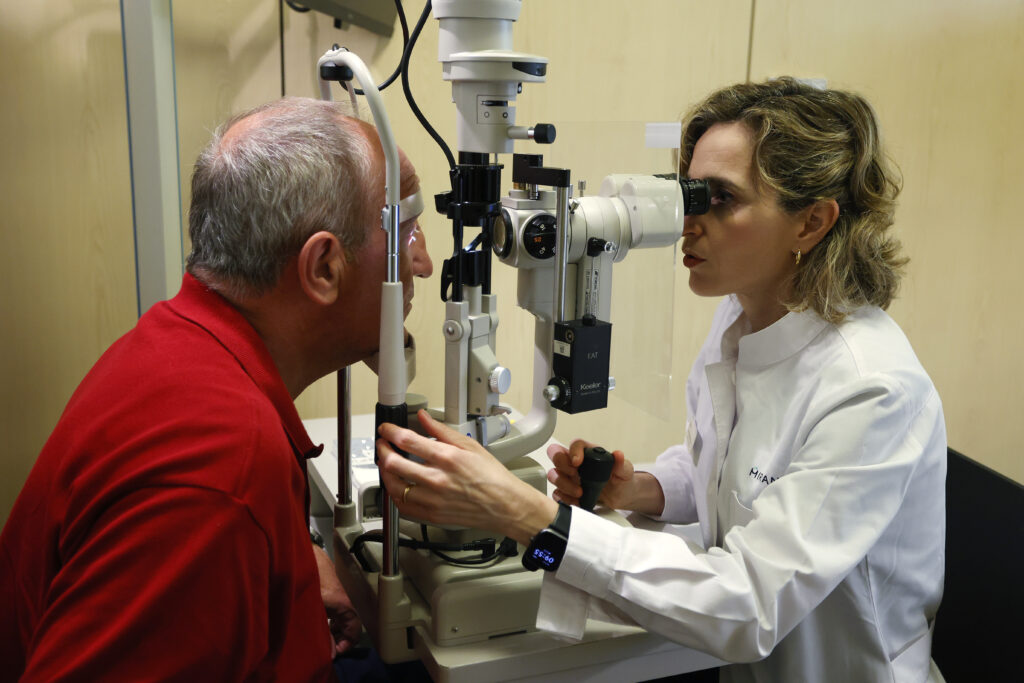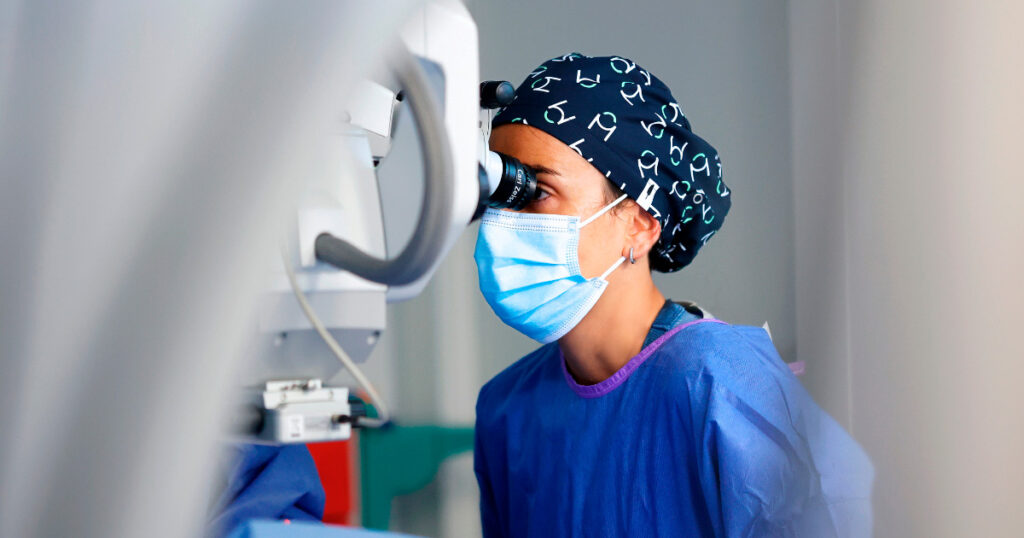
Aging while maintaining good vision is possible with proper prevention and the application of new advances.
In old age, it is very common for various visual impairments to appear as a consequence of the eye’s natural aging process. Regular ophthalmological check-ups are key for the early diagnosis of common conditions such as presbyopia, cataracts, glaucoma, or AMD (age-related macular degeneration).
Taking care of visual health in old age not only allows for the timely detection and treatment of various conditions, but also plays a key role in the well-being and independence of older adults. With proper ophthalmological monitoring and increasingly advanced treatments, it is possible to age with good vision and fully enjoy every stage of life.
On the occasion of Grandparents’ Day, celebrated on July 26, our experts highlight four of the most common age-related eye problems.
- Presbyopia is one of the first conditions to appear, usually starting around the age of 40–45. This condition, also known as “farsightedness” or “tired eyes,” develops progressively as part of the natural aging process, when the lens (the eye’s internal lens) loses its ability to properly focus on close objects. For the ophthalmologists at Miranza, once an accurate diagnosis is made, the specialist can assess the best option to correct it. They explain that in the early stages, the most common solution is to use glasses; however, as presbyopia progresses, many patients choose lens surgery as a definitive solution. This procedure involves replacing the natural lens with an intraocular lens that effectively and safely restores the focusing ability.
It is a minimally invasive technique that allows for a quick recovery. In most cases, patients can return to their normal routine in just 24 hours. This way, the condition is corrected, helping to reduce or eliminate dependence on glasses.
These lenses not only correct the loss of accommodation caused by presbyopia or the clouding of the aging lens typical of cataracts, but also allow for the correction of pre-existing refractive errors such as myopia, hyperopia, or astigmatism. - Cataracts affect practically everyone as they age. This condition occurs when the lens, the eye’s natural focusing lens, gradually loses its transparency, preventing clear light from passing through.
According to our specialists, early treatment of this condition prevents poor vision from significantly limiting daily activities. As the ophthalmologists explain, cataract surgery consists of three steps:- The lens is accessed through a microincision
- The cataract is broken up using ultrasound
- It is replaced with an intraocular lens.
- The lens is accessed through a microincision
It is a safe, minimally invasive technique with long-lasting results.
At Miranza centers, we are experts in implanting lenses known as Premium lenses and are pioneers in introducing new models, offering them to patients with full safety guarantees. In this case, trifocal lenses are most frequently recommended for older patients with cataracts or presbyopia. These lenses allow for clear vision up close, at intermediate distances, and far away, correcting cataracts and improving or eliminating presbyopia.

- Age-Related Macular Degeneration (AMD) is one of the leading causes of vision loss in older adults, in both its wet and dry forms. This condition affects approximately one-third of the population over 70 years old and is the primary cause of blindness in people over 55 in developed countries.
- On one hand, wet AMD is treated with intravitreal injections. The medication is administered using a very fine needle and acts locally, effectively slowing the progression of the disease with minimal systemic side effects. To maintain the results, injections must be repeated periodically, but at Miranza they explain that “currently, we have more effective drugs that last longer inside the eye, significantly reducing the number of injections needed.” This positively impacts the patients’ quality of vision and life.
- On the other hand, dry AMD directly affects the macula, the central area of the retina. In this case, photobiomodulation, also known as low-energy light therapy, offers a new non-invasive treatment alternative. The treatment involves applying low-intensity LED light to the retina with the goal of maintaining and improving visual function without the need for surgery. Clinical trials have shown that improvements can be observed from the first month of treatment, with effects lasting 4 to 6 months after a second treatment cycle.
- On one hand, wet AMD is treated with intravitreal injections. The medication is administered using a very fine needle and acts locally, effectively slowing the progression of the disease with minimal systemic side effects. To maintain the results, injections must be repeated periodically, but at Miranza they explain that “currently, we have more effective drugs that last longer inside the eye, significantly reducing the number of injections needed.” This positively impacts the patients’ quality of vision and life.
- Glaucoma is estimated to affect around 5% of people over the age of 65. It is a condition that often progresses silently, as the loss of the visual field occurs gradually and can go unnoticed until very advanced stages. For this reason, Miranza specialists emphasize the importance of prevention, recommending annual eye exams starting at ages 40–50, especially for individuals with a family history or other risk factors.
Regarding treatment, there are various options such as eye drops, laser procedures, and increasingly less invasive surgeries aimed at controlling intraocular pressure and preserving vision. One of the most significant advances at Miranza centers is Selective Laser Trabeculoplasty (SLT), a treatment that uses a laser to improve fluid drainage inside the eye, thereby reducing intraocular pressure. It is an alternative to chronic medical treatments, offering safe results and improving the patient’s quality of life.
Taking care of the eyes in old age not only allows for the timely detection and treatment of various conditions, but also plays a crucial role in the well-being and independence of older adults. Through proper ophthalmological follow-up and increasingly advanced treatments, it is possible to age with good vision and fully enjoy every stage of life.